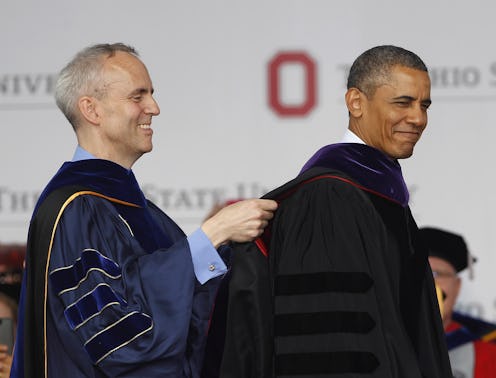News
One Goal Obama Probably Won't Achieve
A generation ago, most Americans were more educated than their parents, and the U.S. led the world in college graduation rates. But things have changed dramatically in two decades: On Thursday, President Obama hosted a higher-ed summit at the White House, explaining to a group of college presidents why programs for low-income students, amongst other measures, were key to meeting the President's 2020 goal. In six years' time, Obama hopes to see America put out a higher proportion of college graduates than any other nation. But is that realistic?
Unfortunately, according to analysts, columnists, and economists, Obama's goal simply isn't going to happen. Considering it's estimated that two-thirds of jobs will require a bachelor's degree or above by 2020, it's no surprise Obama is pushing for a higher proportion of college graduates: a more educated America could energize the economy, reduce the income gap for minorities, and expand the moneyed middle-class.
But Congress doesn't have Obama's back on this one. The president tried to overhaul the No Child Left Behind law, and Congress said no. Obama attempted to provide a universal pre-school system for children, and Congress said — you guessed it — no. "I'm working with Congress where I can to accomplish this," Obama said, very diplomatically, on Thursday. "But I'm also going to take action on my own if Congress is deadlocked."
Make no mistake: America has made higher-ed gains in the last decade. In 2012, ten percent more Americans between the ages of 25 and 29 boasted a bachelor's degree than they had in 1995 — but when it comes to other countries' proportion of college graduates, America is in danger of falling out of the global top fifteen. Once, we were in first place.
So what happened? In short: America is making slow but steady growth in higher education, whereas other developed countries are making much bigger gains, much faster.
Of course, tuition rates are also another huge obstacle in the way of higher-ed gains for America. College costs are on the rise, with even public colleges increasing their tuition fees by more than 70 percent in the last decade. The director of the Georgetown University Center on Education and the Workforce, Anthony Carnevale, told the Wall Street Journal that meeting the president's goal would cost $200 billion more a year. "The issue is, how are you going to pay for it?" he said.
When Obama launched his 2020 goal, he challenged every American to complete at least one year of higher education. And as often happens during recession periods, college enrollment is certainly up — but college graduation remains more stagnant. Forty-three percent of people who enrolled in a four-year degree still hadn't graduated six years later, according to the Department of Education.
Far from moving closer to Obama's 2020 goal, academics believe that the American graduation rate has actually lost ground over the last couple of years. This is partly because of the cuts to higher education, including $12 billion earmarked for community colleges that wound up largely spent on Obamacare. Budget cuts to education have impacted colleges statewide, and have resulted in an almost universal rise in higher-ed fees.
But there is a bit of good news for women. American females are more likely than ever to get a bachelor's degree, and it's actually the men's pass rate that has brought down the national average. In 1976, one in five American women had a bachelor's degree, while today, it's more than one in three. So even if America isn't a world leader in higher ed anymore, women remain leaders in higher ed in this country.
